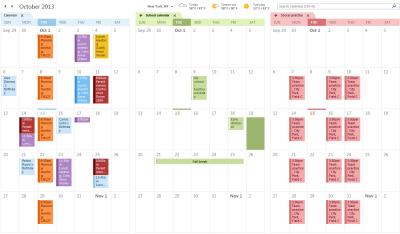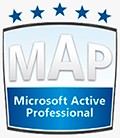

It’s been time since I wanted to write a post like this to help people understand and choose the mailbox to be used with information sharing in organizations with Office365.
Since the point is to be able to implement the most adequate option for managing info to be shared, I’ve decided to name it «Shared info mailboxes on Office365».
So let’s start enumerating the options we have and describe them as well:
- Distribution Groups (DG): although is not a mailbox as well, it’s an option totally valid and recommended to keep in front. These are addresses enabled for sending and receiving departmental messages, but enabling all those messages to be distributed to their members as let them to respond as the department and no as individuals. It has no cost and you can practically create as much DGs as you want to.
-
Shared Mailboxes: this type of mailbox allows us to send and receive departmental messages (i.e:
administration@contoso.com) working like a team on a separate space than the personal mailbox, without the need of an additional license (as long as you don’t exceed the 5Gb storage limit, if you want more then you must assign a license allowing you to get up to 25Gb). Of course the user will still need an individual Exchange Online license assigned in order to access this mailbox.
- Site Mailboxes: it’s like a shared mailbox, but the difference is the Platform where it resides, specifically in SharePoint Online so it can be viewed as a library inside the intranet portal keeping the attachments and Exchange Online for saving the body of the messages. This type of mailbox can be mail enabled in order to receive messages but doesn’t allows you to send messages as a departmental unit. It’s limit is 5Gb and needs no license to be assigned, but the user still needs an Exchange Online and a SharePoint Online license.
- Modern Public Folders: that’s it, «Modern». Due that Microsoft removed the public folders functionality of their online Platform and now they’ve implemented it, they’ve decided to do it using the Exchange 2013 technology with some performance improvements. This the of mailbox is maybe the most comfortable of the options when it has to do with large orgs because it has no hard limits on the number of concurrent connections to it. As same as the rest of the options, it doesn’t need no license to be assigned but of course the users that want to access them still need an Exchange Online license to be assigned. Its limit is awesome compared to the other options as it gives 25Gb per public folder mailbox and you can get up to 50 public folder mailboxes, that’s about 1,25Tb of free storage.
In order to make things easy for you, I’ve decided to make a comparison table of what I think are the most important things to keep in mind when making a decision over every situation:

It’s not a big thing but sure helps someone. Although I will be writing a single post for ever type of mailbox named here so I can show up how to configure them and tell the positive and negative things about them.
Until next one!
Me gusta:
Me gusta Cargando...



On this post i´ll explain something that´s been a problem for most of us at the time of migration from on-premises Exchange to Exchange Online… Public Folders.
When Microsoft published his first versión of Microsoft Exchange as SaaS (Software as a Service) named BPOS, it didn´t Support public folders otherwise it was an hybrid environment in this would have been stored on-premises and probably implement this feature on the next versión of the platform (Wave 14). Well the next version came and the feature wasn´t supported, even more, Online services Support told it was never going to be introduced because it was an obsolete feature also to be removed from on-premises future products. To workarround this area we have some alternatives like shared mailboxes or sharepoint libraries, but they´re not enough.
Finally Microsoft made a great effort afert listening the IT Community and who are in charge of such migrations, introducing two new features onto Exchange Onlines new platform (Wave 15): Public Folders and Site Mailboxes.
On todays post i´ll be centered only on public folders, maybe it can result a Little bit long but it´s worth it.
First of all, the limitations:
- It´s not recommended to use this feature for archiving, for this purpose there´s the archiving feature available on Exchange Online Plan 2 and Office365 Plan E3 or even document libraries available on Sharepoint Online.
- It´s very important not to store more than 5000 elements on the main folders. This is more an Outlook limitation than Exchange Online because in theory storing beyond that number Outlook will begin to reduce its performance and so on we´ll get errors and pauses like «Outlook is not responding» (even if it does in a while).
- Public Folders are compatible with OWA, besides it will not be posible to create or delete them.
- The content of those folders are not indexed by Exchange Search, so we could search of a single folder but not in recursive mode.
- Retention policy tags are not compatible.
- It´s mandatory to use Outlook 2007 or newer (obviously).
Things to keep in mind:
- We can store documents, mails and messages.
- We can mail-enable public folders to receive automatically mails or even make them form part of a Distribution Group.
- When mail-enabling a public folder, we can configure limits and assign permissions to SendOnBehalfOf and SendAs.
- The changes will be synced every 15 minutes if there are users connected, if there aren´t any, it will do every 24 hours. Besides if the modification occurs on a root structure, the changes will be synced inmediately using an asynchronous sync.
Public Folders set-up on Exchange Online
Once we know the limitations and the things to keep in mind, lets proceed to configure this new feature:
- First of all, Access the Office365 Portal with our Admin credentials and click on Admin – Exchange to enter the Exchange Online admin console.

- Then click on Public Folders located on the left side.

- Click on the Public Folders Mailboxes located on the upper side.

- Hit the «+» button to create a new mailbox and indicate a name (i.e. IT) and hit on Save.

- Once it´s been created the public folder mailbox, lets create a new public folder structure, to do so, click on the upper side where it says Public Folders.

- Hit the «+» button to create a new folder, indicate a name and hit on save.

- Then hit on the Pencil button to edit the recently created folder and configure features like retention policies (do not confuse with retention tags), limits and read mark status (user based or general)

- Once done, assign permissions, simply click on the right side link where it says Folder Permissions and click on Manage.

- Once inside we can give users access to this folder and wich permissions will it have (including the visible folder permission).


- Repeat the process with all the folders we want and give a shape to the structure we want.
Now the checking part:
- Enter our Outlook and Enable the folders view (it´s the only way to view public folders in Outlook).

- Observe the public folders located on the bottom side. In my case, i´ve created two profiles, Josh Smith (User) and Alberto Pascual (Admin) in order to demonstrate the differences on the applied permissions. I´ve created a folder structure wich has three folders, one root folder (Cloud Support) and two child (E Plans y P Plans). Josh has view only permissions on the P Plans folders and the first image shows it, and on the second one shows Alberto structure:


Well, we´ve created a public folder mailbox, a public folder structure, assgined permissions and checked through two profiles on Outlook, but How do we do it on OWA?
- Access our OWA
- Right Click on the Favorites and click on Add Public Folder

- Select a folder to show and click on Accept. you´ll see the differences of the permissions applied to both users, Josh (first image) and Alberto Pascual (second image).


- We´ll have the public folders listed on the upper side on the favorites area.

Hope many of you find it useful.
Me gusta:
Me gusta Cargando...

























